Fortunately we knew it, the border between Laos and Cambodia was not the most friendly. All the reasons are valid to extort you some dollars. It began at the exit of Laos where customs officer asked us 2$ each to get out exit stamps. We heard if you insist and wait, sometimes they give away. It was not really important for us to save our 2$ but we didn’t want to give away before this fraud. After 45mn of rejection, they asked us if we have some kips (laotian currency). Noting they didn’t want to abandon we accepted and gave them our kips, we had a bit more of 2$. We tried.
Then Cambodian border. After escaped the fake doctor who take your temperature and then ask you 2$, we asked our visas, 30$ each. They wanted 35$. Of course, 5$ for the stamp! We did smiling and stupid people, we didn’t understand. They decided to give back our passports, we stamped them a bit further. Let’s go! It was almost noon.
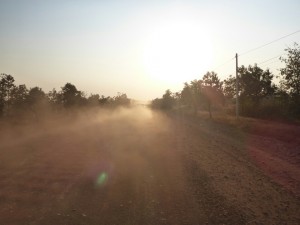
Poussière sur la route | Dust on the road
Our first day on the Cambodians roads is memorable. The heat was stuffy. We hadn’t warm like that for long time. The road was not always good, some asphalt parts alternate with red soil roads. When trucks and cars passed, we ate the dust. Drivers drove very fast and horned to say that they were arriving but they won’t slow down. Besides blazing fields and roadsides asphyxiated us with their thick smock. Shadow was rare and the small restaurants on the way were absent. Houses on stilts strewed the roadsides. Fanchon couldn’t put up with her saddle. We didn’t know why. We rode this day a bit more than 85km to reach Stung Treng, the first city of the region. We stayed only one night and took a night bus to Phnom-Penh because here if you buy a seat you have to buy a whole bicycle.
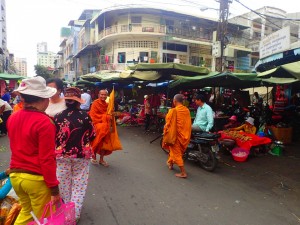
Phnom-Penh
Phnom-Penh is the capital city of Cambodia. There is not many things to do but the atmosphere is nice. We spent 6 days, just the time to wait our visas to Myanmar. To killing time, we spent several hours in the library of the french institute full of interesting books. We saw the national library too but it is very poor and books are old. In the french institute we participated in a conference about architecture and paintings of Buddhist temples before 1975. It was very interesting, after that we looked the temple with new eyes.
In Phnom-Penh, we visited also the S-21. This ancient college was transformed in jail during the Khmers Rouges period, starting from 1975. Today accessible for visitors, this place tries to testify about this terrible period and this one doesn’t forget by people.
The Khmers Rouges took the power after several years of civil war. At the beginning, the people welcomed with enthusiasm this new Communist regime. They were quickly disappointed. Between 1975 and 1979, when they ruled Cambodia, the Khmers Rouges set a very violent dictatorship.
As soon as they arrived in the capital city, with the pretext of a near American bombardment (they were numerous on the Hô Chi Minh road along the Vietnamese border), the Khmers Rouges evacuated the population of Phnom-penh, i.e. about two millions of people. They were forced to “provisorily” leave their home and walk to the countrysides, in disastrous conditions. Old people, pregnant women and sick people were with everybody.
The government politic headed to exterminate “the new people” : professors, military people, intellectuals, students, engineers… in favour of “the basic people” the peasants. The democratic Kampuchea government wanted to re-educate all the people to destroy the idea of private property and all the cultural bearings leading to the ancient society. The currency was abolished. Families were dismantled, the villagers mixed to avoid any possibility of organised opposition. The collectivization caused the rationing of food. But the poor management of the agriculture put the country in famine. Away from modernity, people were forced to leave the machine and work as beast. During this time, a large part of the population died of hunger.
Numerous prisons were erected in all the country and torture centers were used to make talk the spies, innocent who finished by confess to acts they didn’t committed. “It is better to kill an innocent than to keep alive an enemy”.
The country was liberated by the Vietnamese people on the 25th of December 1978. The Khmers Rouges withdrawed near the Thailand border. In order to destabilise the new government set by the Vietnamese, the Khmers Rouges mined the countrysides with landmines. These mines do not kill but mutilate. Their purpose was to frighten the people to they do not work anymore. Today there are still millions of landmines in Cambodia. So, we don’t get off the beaten track, wild camping is difficult.
After pick up our bicycles in Stung Treng, we rode toward Siem Reap, the city where are located the famous Angkor Wat. We needed four days by bike. The third day Gabriel began to feel bad and had fever. The fourth day was not better. After about ten kilometres we stopped one of the taxi vans and put our bicycles in and we went to Siem Reap.
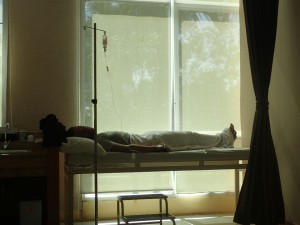
Gabriel a la dengue | Gabriel caught the dengue fever
We told to each other “We can’t be sick in Cambodia”. Hospitals are not very sure and half of the drugs are counterfeits from Vietnam. If you are lucky they are only placebo, if not they are poison. We looked for a hospital not to far from the center, the only one was the local one. But when we arrived we don’t know really where to go. Nobody speaks English and after few minutes we understand they didn’t work before 2 p.m.!
We changed our plans, toward the private hospital 5km from the center. Hospital or medicalised hotel !? But there, everybody spoke English and Gabriel was like the king. Of course when you see the price! The verdict was dengue fever. After 5 days spent to sleep with fever, Gabriel went back to the hospital to make a second blood test. It was worse, they decided to keep him for 4 days.
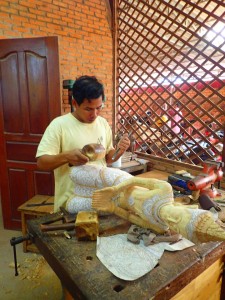
Siem Reap : ateliers d’artisanat | Traditional workshops
At the same time, Fanchon occupied herself as she could. Except the Angkor temples, there is no many things to do. This very touristic city contained mainly souvenir shops and restaurants. She chosed handcraft workshop. Numerous schools and associations are established to conserve the Cambodian know-hows (weaving, ceramic, sculpture with wood or stone). She also went to see the Phare circus. Circus school opened in the 90s. Poor youngs people were trained to the show and art of music.
When she ate her meals in the guest house in front of ours she met several french people. Rémi come to make a movie about Angkor and Philippe an expatriate for almost 10 years. Philippe explained her a lot of things about Cambodia. Corruption is something normal here and for the different social classes. People know and do it. We have to accept it even if at the beginning it is not very easy for a foreigner.
He also spoke about NGO. Most of them would be today more harmful than beneficial. Very useful in 90’s when the country was in difficulty, now, sometimes they prevent Cambodian people to do things by themselves. He told her some baffling examples. The leader of one village had deforested a huge area to plant rubber trees. After that, a plan of reforestation was proposed with of course a big cheque. He accepted only for one part of land, keep the money but prefered keep the rest of the place to plant rubber trees, more profitable.
There is also one leader of village who blackmail the biodiversity researchers. He said, if you don’t want to pay, it is OK, I will destroy all the forest and I will plant other trees.
Cambodians seem to be not very engaged for the preservation of their environment and they don’t ask themselves questions, especially when they could make money.
It’s important to know population is not well educated. The schools we saw on the sides of the roads looked like kindergartens. Philippe confirmed this, education is a real problem in Cambodia. When the Khmers Rouges eliminated every intellectuals, they impoverished the country. Teachers nominated after this period were chosen only because of their good relationships with kids and seemed to be the most educated. Now, the country just begin to have good teachers.
75% of the orphanages are not real. They are only traps for tourists, they charge the visited and ask for donations.
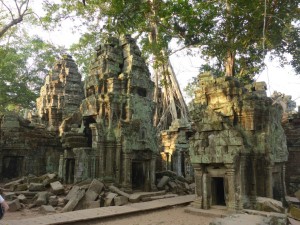
Angkor : Ta Prohm
We finished our stay by the visit of temples of Angkor. Built about the XII century, the sites are well preserved, the first vestiges were discovered by french explorer 150 years ago.
We had in Cambodia numerous program changes and setback. We often had to adapt us. Out of the cities there were few things to do and see. Landscapes on the road were distressing, huge flat field burned, where some trees survive.
We left Cambodia the 6 of February to come back in Thailand.
